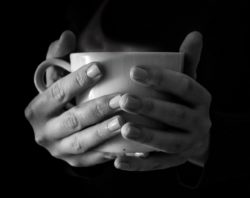
I was eighteen years old, working my first full-time job and trying to fit in with a mature group of women from the phone company’s payroll department. (In those days, there was only one “phone company.”) It was a highly regimented environment. We were allowed two fifteen-minute breaks per day, including “travel time” to and from the cafeteria. I looked down the line and saw soft drinks, milk and two gigantic stainless steel urns of coffee – caf and decaf. Each of the women ahead of me in line grabbed a thick ceramic mug and filled it with coffee. Wanting to fit in, I did the same. Then I added cream from what seemed like a gallon-sized icy cold pitcher, took several sugar packets and a teaspoon – with the Bell System logo engraved on the handle – and followed my new co-workers to the table. There, I doctored my cup with two sugars and stirred. Slightly bitter. I added another sugar and tasted again. To my delight, I found it tasty and, a few minutes later, I felt a burst of energy. I’ve been a coffee addict – no, make that aficionada – ever since.
A beta reader of my newest Angelina Bonaparte mystery, Cash Kills, noted that there were too many references to coffee in my books. I checked. In Truth Kills, the first in the series, coffee is mentioned fifty-nine times. It gets eighty mentions in Cash Kills. I’m only fifty pages into Deception Kills, and I counted thirteen uses of the word ‘coffee’ so far. Excessive? Not if you love coffee, and Angie does! So does Bobbie Russell, her cohort in the Cash Kills investigation. And Ted Wukowski, her love interest. And Bart Matthews, the Mafia lawyer who’s helping her find the sources of the hidden wealth of her client’s murdered parents. And … just about every character I wrote. It’s my mindset. I can’t imagine going hours, much less days, without coffee.
Coffee drinkers don’t consume it simply for the flavor or the little rush. We associate coffee with places and times, with feelings and occasions. Angie starts her day with coffee. (Sixty-five percent of coffee is consumed at breakfast.) Bobbie brews it as a hangover remedy for his friend Guy. While being interviewed at the Milwaukee Police Department’s homicide division, Angie observes that “Police issue coffee sits on the burner all day and the pot is almost never cleaned. Lethal stuff.”
I’ve been known to laughingly say that even bad coffee is better than no coffee at all. (I did not plagiarize this from David Lean. It is an original thought occurring independently between us, like calculus, Newton and Leibniz.) How could it be otherwise? We writers, at least in the US, are known for guzzling coffee as we struggle to get words on the page. I am no exception. I start my day with a caffeine infusion and then change over to decaf, due to a dratted heart rhythm problem. In the afternoon, I’m allowed a second serving of caf and I don’t waste it on soft drinks! It’s java for me. Coffee fuels my writing and, quite honestly, the rhythm of my days. I’m right there with T.S. Eliot, who wrote: “I have measured out my life with coffee spoons.”
We refer to coffee in lots of ways that reflect our state of mind and the culture: morning thunder, mother’s little helper, wakey juice, brew, C8H10N4O2 (the molecular formula for caffeine – probably only used by scientists!) … The list is long, I think because we Americans have a love affair with coffee. I’ve graduated from my youthful days of drinking it like syrup, to appreciating a full-bodied blend, with just a slug of cream.
Want to read some great mysteries that focus even more on the brew than mine do? Pick up Sandra Balzo’s Maggie Thorsen series, or Cleo Coyle’s Coffeehouse Mysteries. Or learn how coffee was introduced into English society and its economic impact, from David Liss’ highly acclaimed and entertaining The Coffee Trader. And while you’re reading, enjoy a cup of Joe!
Originally posted on The Editing Pen.
